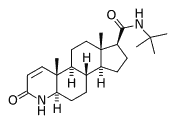The drug finasteride plays a curious dual role: It can help a man grow back thinning hair and also alleviate urinary problems. The drug achieves both effects by ratcheting down production of dihydrotestosterone, a hormone linked to male pattern baldness and enlargement of the prostate.
Researchers funded by the National Cancer Institute now report that finasteride also prevents some cases of prostate cancer. Merck and Company of Whitehouse Station, N.J., markets finasteride as Proscar for prostate problems and, in a lower dose, as Propecia for baldness. The company has not announced whether it will ask the Food and Drug Administration to approve finasteride for prevention of prostate cancer. Some cancer specialists, however, doubt that the drug will have widespread value in protecting men against the disease.
In 1994, researchers began recruiting healthy men over age 55 who showed no signs of prostate cancer in physical examinations and blood tests. The scientists randomly assigned 18,882 men to receive a daily finasteride pill or a placebo.
During the trial, the men underwent annual examinations and blood tests, which were followed by biopsies when warranted. The biopsies revealed cancers among 571 men in the placebo group but only 435 of those getting finasteride, reports Ian M. Thompson of the University of Texas Health Sciences Center in San Antonio.
The researchers combined those data with results of biopsies of seemingly healthy men as they reached the end of their 7-year participation in the study. The biopsies turned up hundreds of hidden cancers in both groups. Overall, 18.4 percent of 4,368 men who had taken finasteride and 24.4 percent of 4,692 men getting the placebo were diagnosed with prostate cancer. However, aggressive forms of prostate cancer showed up in 6.4 percent of men on finasteride and in only 5.1 percent of those taking the placebo.
The apparent overall benefit of finasteride led an independent oversight panel to stop the study 15 months early, before the remaining men underwent a biopsy, says Phyllis J. Goodman of the Fred Hutchinson Cancer Research Center in Seattle. The findings will appear in the July 17 New England Journal of Medicine (NEJM).
"This is the first intervention that is proven to reduce a man's risk of prostate cancer," Thompson says.
Some scientists argue that the findings don't warrant the drug's use as a preventive treatment. John D. McConnell of the University of Texas-Southwestern in Dallas notes that doctors did cancer biopsies at the end of the study but not at the start. So, some men might have had microscopic prostate tumors all along, he says. While finasteride might have kept some hidden cancers in check, assessing the drug's protective effect is difficult when the volunteers' original cancer status is uncertain.
"I would be very cautious about recommending finasteride to a patient purely to lower prostate cancer risk," says McConnell.
Furthermore, "the study results suggest that finasteride may accelerate the growth of high-grade [aggressive] cancers," says Peter T. Scardino of the Memorial Sloan-Kettering Cancer Center in New York, writing in the same issue of NEJM. The drug could limit cancers dependent on dihydrotestosterone but give other cancers a competitive advantage, he says.
COPYRIGHT 2003 Science Service, Inc.
COPYRIGHT 2003 Gale Group



